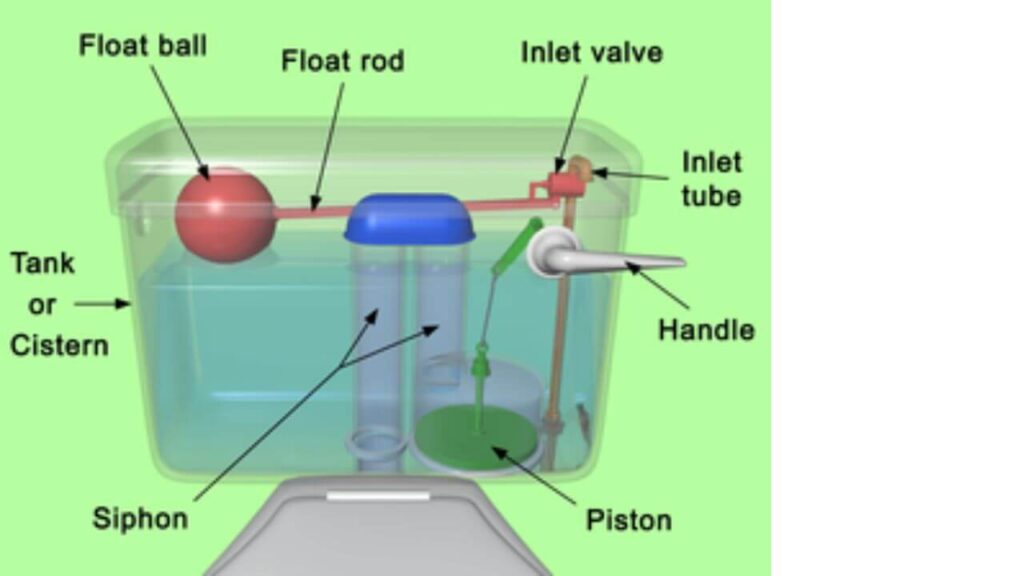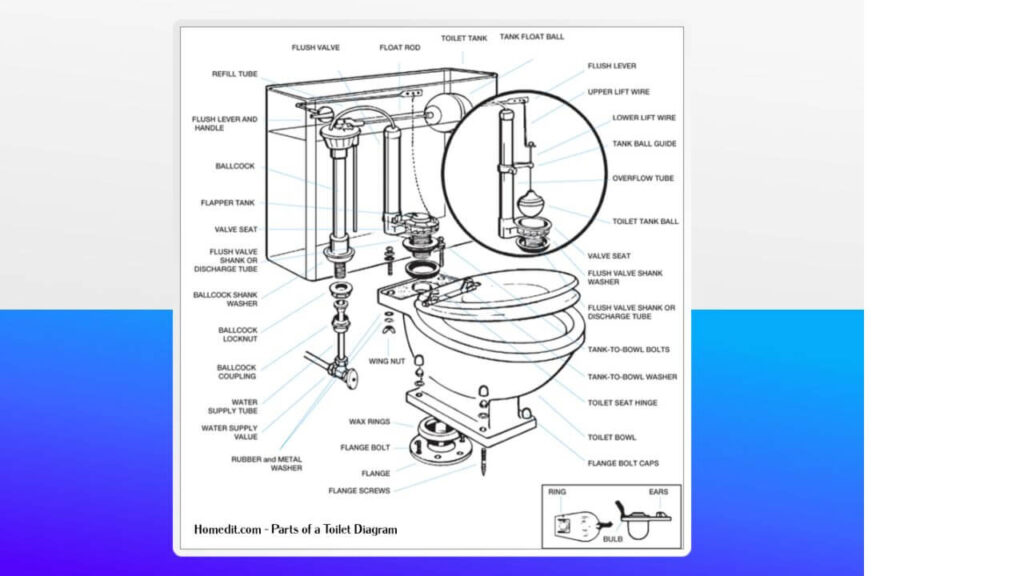Have you ever taken a moment to consider how does a toilet flush work? I bet not…because it just does. Right? Since childhood, I have wondered how this little mechanism works and magically disappears waste.
This curious nature forced me today to write this detailed guide for people like me who wants to know how this all happens.
It sounds like rocket science, but it’s simple and easy to understand. I will try to guide you in short.
Toilet flushes work using water released through a valve at the bottom of the toilet. The water then flows through a tube to the toilet paper dispenser and is used to clean the toilet.
But for better understanding, we need to study this mechanism in-depth, and here is your guide.
How Do Toilets Flush?

If you’ve ever been curious about the answer to this question, you’re not alone. Many people, including me, are interested in knowing how toilets flush, and for a good reason—it’s science.
I like to keep the answer simple and short for a better understanding: a toilet flushes by using gravity to push water down through the pipes and into the sewer. But there’s more to it than that.
There are two types of toilets: gravity-flush and pressure-assist. Gravity-flush toilets rely solely on gravity to move the water from the bowl through the pipes and out into the sewer system.
Pressure-assist toilets use air pressure to force water through the pipes. Pressure-assist toilets are standard in public restrooms because they’re stronger than gravity-flush models.
Flushing Mechanism: How Does A Toilet Flush Work?

Flushing a toilet is a simple task to which most of us don’t give much thought. But if you’re curious about how the mechanism works or want to know what exactly happens when you push that lever, this article is here to help.
As with any mechanism involving water and waste, flushing toilets has an underlying complexity. But it’s not so scary once you know the basics of how it all works together.
Step 1: The handle is pushed down, lifting the rubber flapper.
- An overflow tube lifts a small ball or float when you pull up on your toilet handle. The ball/float drains water from your toilet tank into the main drain.
- When there isn’t any more water in your tank, air rushes into this space causing splashing noises around your seat while you do business.
- Don’t worry! Don’t startle yourself by jumping off too early when you hear those gurgles.
Step 2: When The Flapper Is Lifted, Water Rushes From The Tank Into The Bowl.
The flapper is a rubber flap at the bottom of the tank. It’s held in place by a chain and attached to an arm that moves when you push down on the handle. When you flush, this arm lifts the flapper so water can rush from the tank into the bowl.
Step 3: The Refill Tube Then Sends Fresh Water From The Tank Into The Bowl To Fill It Back Up After It’s Been Flushed.
The refill tube is a siphon that carries water from the tank to the bowl. The tube is open at the top but closed at the bottom, so air moves out of the tank and down into your toilet bowl when you flush.
As soon as this happens, gravity pulls fresh water from above into the bowl below it—and voila! You’ve flushed away any evidence of what was once in there (or on there).
Once all that dirty stuff has been flushed away by fresh water from above, your toilet will refill with clean water before you can even say “flush.”
Step 4: Water Passes Through To Create A Siphon
Once the water has passed through and begun to fill the bowl, a siphon is created, which pulls waste out of the bowl and down into the tramway.
To understand how this works, it’s essential to know that there has to be a difference between the water height in both tanks—the tank must have more than enough volume so that when you flush, some wastewater will be left behind in your toilet bowl.
Freshwater drips down your tank from above when you pull on or push down on your handle (or tap). This causes more pressure within your tank than what’s happening outside.
The pressure below remains relatively steady as long as there isn’t any leakage from cracks or other defects in its makeup (more on this later).
Step 5: After flushing, float valves restore water levels.
The float valve closes off the intake and allows water levels to return to normal. This readies it for your next flush!
The chain on top of the lift arm pulls down as you push the lever, which causes the flapper to open and allow water into the bowl. Water fills up until it hits its highest point, gravity takes over, and nature happens.
When all’s said and done, the flapper closes again, rinsing everything clean — but that’s not all there is to a flush.
It’s Pretty Simple!
It’s pretty simple! You can do it yourself. It’s not magic or hard to understand or fix, but it takes time and effort. This is why most people have a plumber come in when they have problems with their toilets.
The flushing mechanism of a toilet is simple enough that even a child could be taught how it works:
Flush Times: How Long Does It Take For A Toilet To Flush?
Flush times are a big deal. After all, if your toilet flushes too slowly, you might end up with a clogged drain and an entire house full of water. That’s no good.
But how long does it take for a toilet to flush? Well, it depends on the type of toilet you’re using. Here’s a list of some common toilet types and their average flush times:
Type of Toilet: Average Flush Time (seconds)
1. Gravity Flush: 1.5 seconds
2. Pressure-Assisted Flush: 1.8 seconds (The pressure-assist feature helps push waste down through the pipes.)
3. Dual Flush: 1.5 seconds (This type uses two buttons to flush: one for liquid waste and one for solid waste.)
You can also read our blog How To Flush A Dual Flush Toilet to know the core working of dual flush toilet.
How Much Is Water Flushed Each Time A Person Uses A Toilet?
Well, this question has come to my mind since childhood. But now, after working as a professional plumber, I have the answer to this question, and I would love to share it with you.
According to the EPA, each toilet flush uses about 3.5 gallons of water. That’s a lot! But it’s nothing compared to what we’re using to flush our toilets in other ways. If you use a low-flow toilet, that saves you 1.6 gallons of water per flush
But according to one study, Americans flush an average of 6 times per day. That means we use about 12 gallons of water daily on our toilets alone. That adds up: if everyone in the U.S. used low-flow toilets for one year, we’d save about 10 billion gallons of water.
When you flush a toilet, you send between 1-2 gallons of water down the drain. The amount of water used depends on the size of your toilet and how long it takes to fill up. An older toilet with a smaller flush valve will take less time to fill up and therefore use less water.
Read our guide: How Much Water To Flush a Toilet
Why Is It Important To Flush A Toilet Regularly?
Now maybe most people think that if we waste so much water during flushing, why do we flush regularly? Let me tell you, flushing a toilet is essential for a few reasons. First, it helps to keep your toilet clean.
If you don’t flush regularly, then there’s a good chance that your toilet will become blocked with waste and other materials. This can cause odors to develop in the bathroom and around the house.
Second, flushing regularly helps prevent the spread of bacteria and germs from one person’s waste to another person’s hands when they use the bathroom.
When you flush regularly, this reduces the risk of spreading bacteria or germs to other people who may come into contact with them later.
Finally, flushing regularly helps keep your pipes clean and running smoothly. So that they don’t clog up or break down prematurely over time due to corrosion buildup caused by mineral deposits caused by hard water deposits (which are common in most areas where there is low rainfall).
Related blog:
How Often Should You Flush An Unused Toilet
Conclusion
In conclusion, a toilet flush works by pushing water up a tube and out a hole in the bottom. This caused the toilet air to be vacuumed and swept away.
The suction then pulls the dirt and other debris out of the hole, releasing the water.
I do hope that this article helps you to understand how does a toilet flush work. But if you still have any queries or questions regarding this topic, feel free to contact me.
